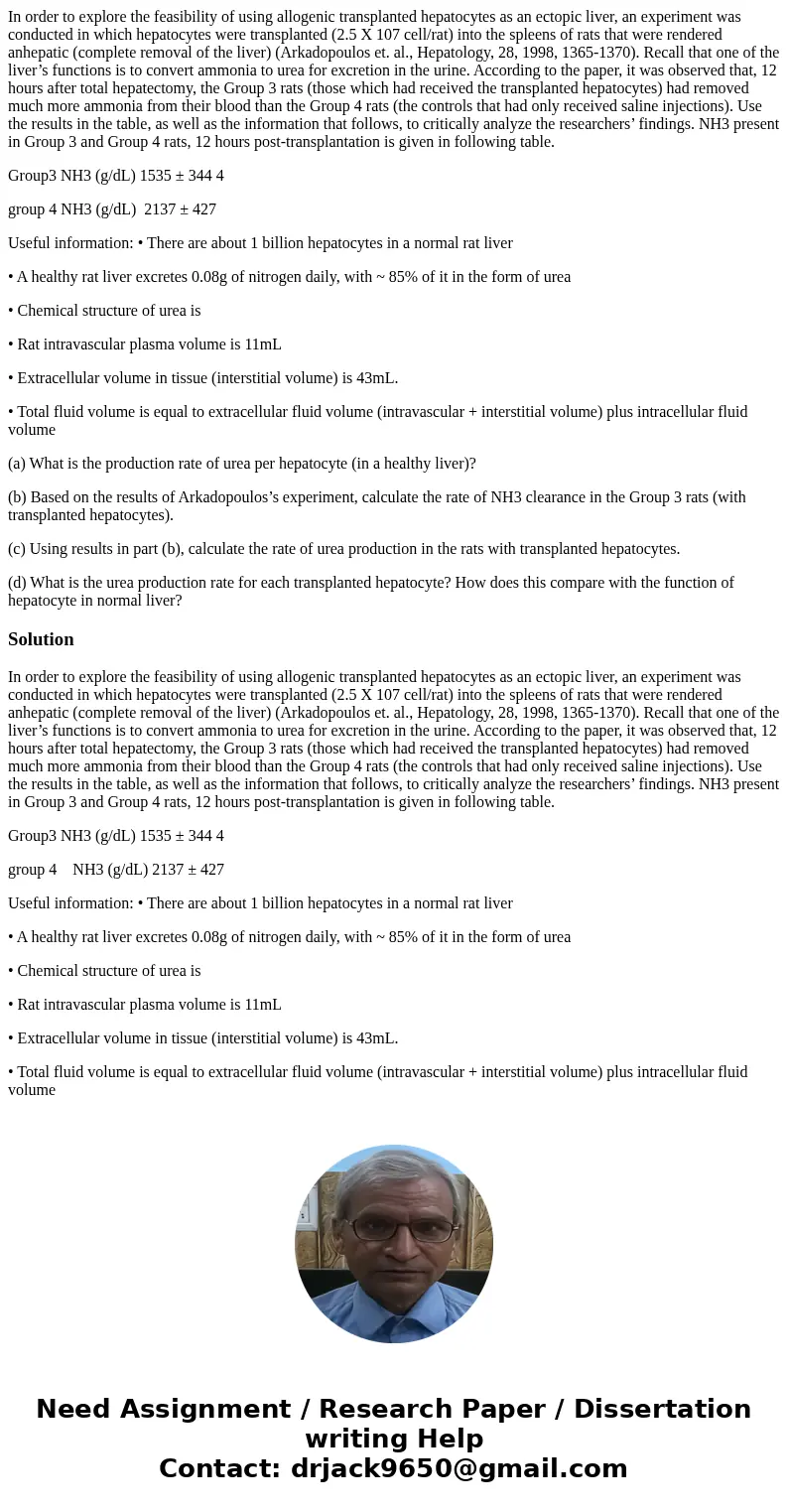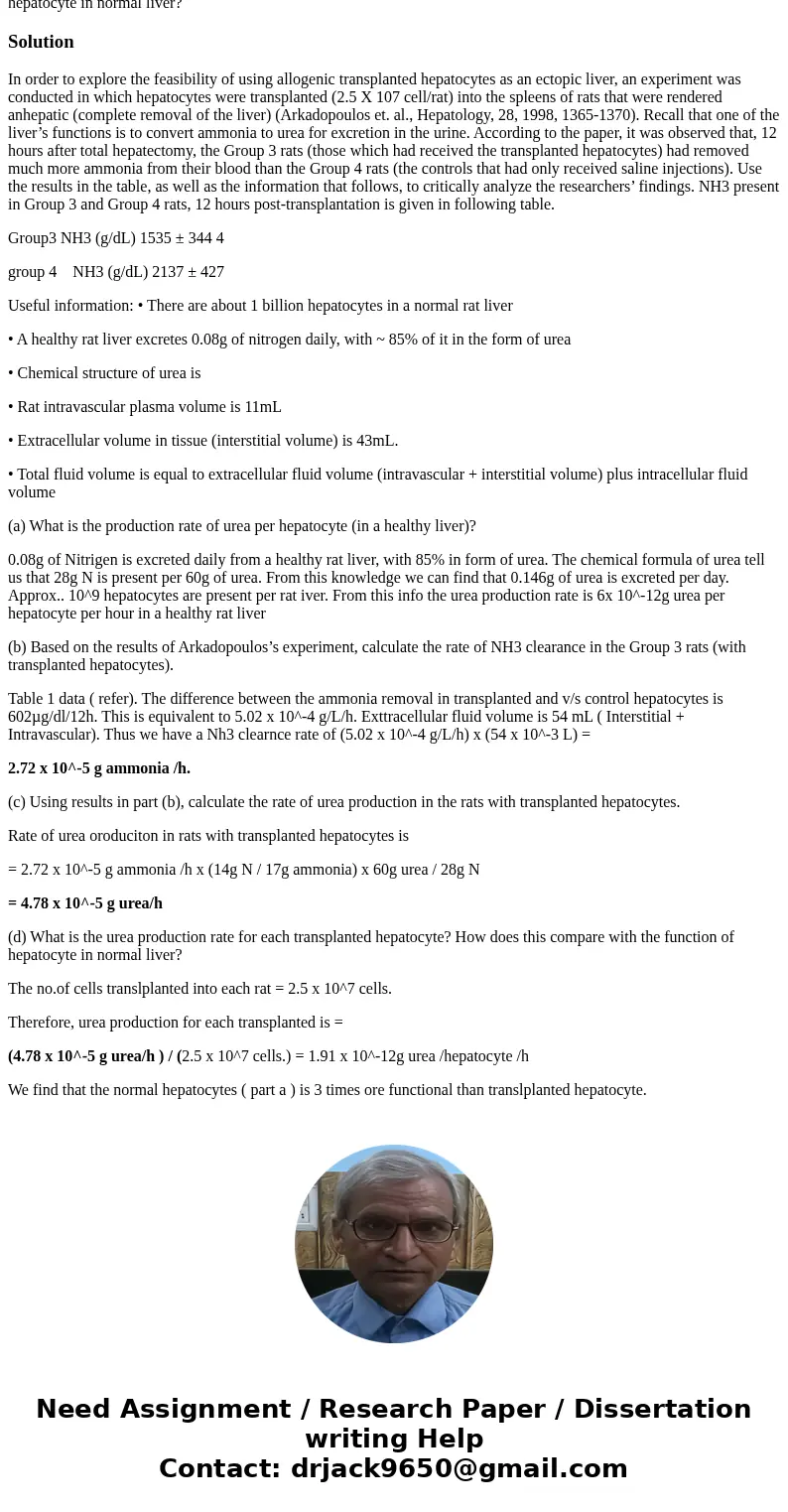In order to explore the feasibility of using allogenic trans
In order to explore the feasibility of using allogenic transplanted hepatocytes as an ectopic liver, an experiment was conducted in which hepatocytes were transplanted (2.5 X 107 cell/rat) into the spleens of rats that were rendered anhepatic (complete removal of the liver) (Arkadopoulos et. al., Hepatology, 28, 1998, 1365-1370). Recall that one of the liver’s functions is to convert ammonia to urea for excretion in the urine. According to the paper, it was observed that, 12 hours after total hepatectomy, the Group 3 rats (those which had received the transplanted hepatocytes) had removed much more ammonia from their blood than the Group 4 rats (the controls that had only received saline injections). Use the results in the table, as well as the information that follows, to critically analyze the researchers’ findings. NH3 present in Group 3 and Group 4 rats, 12 hours post-transplantation is given in following table.
Group3 NH3 (g/dL) 1535 ± 344 4
group 4 NH3 (g/dL) 2137 ± 427
Useful information: • There are about 1 billion hepatocytes in a normal rat liver
• A healthy rat liver excretes 0.08g of nitrogen daily, with ~ 85% of it in the form of urea
• Chemical structure of urea is
• Rat intravascular plasma volume is 11mL
• Extracellular volume in tissue (interstitial volume) is 43mL.
• Total fluid volume is equal to extracellular fluid volume (intravascular + interstitial volume) plus intracellular fluid volume
(a) What is the production rate of urea per hepatocyte (in a healthy liver)?
(b) Based on the results of Arkadopoulos’s experiment, calculate the rate of NH3 clearance in the Group 3 rats (with transplanted hepatocytes).
(c) Using results in part (b), calculate the rate of urea production in the rats with transplanted hepatocytes.
(d) What is the urea production rate for each transplanted hepatocyte? How does this compare with the function of hepatocyte in normal liver?
Solution
In order to explore the feasibility of using allogenic transplanted hepatocytes as an ectopic liver, an experiment was conducted in which hepatocytes were transplanted (2.5 X 107 cell/rat) into the spleens of rats that were rendered anhepatic (complete removal of the liver) (Arkadopoulos et. al., Hepatology, 28, 1998, 1365-1370). Recall that one of the liver’s functions is to convert ammonia to urea for excretion in the urine. According to the paper, it was observed that, 12 hours after total hepatectomy, the Group 3 rats (those which had received the transplanted hepatocytes) had removed much more ammonia from their blood than the Group 4 rats (the controls that had only received saline injections). Use the results in the table, as well as the information that follows, to critically analyze the researchers’ findings. NH3 present in Group 3 and Group 4 rats, 12 hours post-transplantation is given in following table.
Group3 NH3 (g/dL) 1535 ± 344 4
group 4 NH3 (g/dL) 2137 ± 427
Useful information: • There are about 1 billion hepatocytes in a normal rat liver
• A healthy rat liver excretes 0.08g of nitrogen daily, with ~ 85% of it in the form of urea
• Chemical structure of urea is
• Rat intravascular plasma volume is 11mL
• Extracellular volume in tissue (interstitial volume) is 43mL.
• Total fluid volume is equal to extracellular fluid volume (intravascular + interstitial volume) plus intracellular fluid volume
(a) What is the production rate of urea per hepatocyte (in a healthy liver)?
0.08g of Nitrigen is excreted daily from a healthy rat liver, with 85% in form of urea. The chemical formula of urea tell us that 28g N is present per 60g of urea. From this knowledge we can find that 0.146g of urea is excreted per day. Approx.. 10^9 hepatocytes are present per rat iver. From this info the urea production rate is 6x 10^-12g urea per hepatocyte per hour in a healthy rat liver
(b) Based on the results of Arkadopoulos’s experiment, calculate the rate of NH3 clearance in the Group 3 rats (with transplanted hepatocytes).
Table 1 data ( refer). The difference between the ammonia removal in transplanted and v/s control hepatocytes is 602µg/dl/12h. This is equivalent to 5.02 x 10^-4 g/L/h. Exttracellular fluid volume is 54 mL ( Interstitial + Intravascular). Thus we have a Nh3 clearnce rate of (5.02 x 10^-4 g/L/h) x (54 x 10^-3 L) =
2.72 x 10^-5 g ammonia /h.
(c) Using results in part (b), calculate the rate of urea production in the rats with transplanted hepatocytes.
Rate of urea oroduciton in rats with transplanted hepatocytes is
= 2.72 x 10^-5 g ammonia /h x (14g N / 17g ammonia) x 60g urea / 28g N
= 4.78 x 10^-5 g urea/h
(d) What is the urea production rate for each transplanted hepatocyte? How does this compare with the function of hepatocyte in normal liver?
The no.of cells translplanted into each rat = 2.5 x 10^7 cells.
Therefore, urea production for each transplanted is =
(4.78 x 10^-5 g urea/h ) / (2.5 x 10^7 cells.) = 1.91 x 10^-12g urea /hepatocyte /h
We find that the normal hepatocytes ( part a ) is 3 times ore functional than translplanted hepatocyte.


 Homework Sourse
Homework Sourse